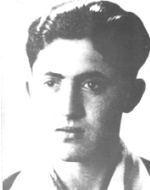Meir was born on February 19, 1925, in Poland. He grew up in Galicia, in the southern part of the country, north of the Carpathians, an area that surrounds the slopes of the mountains and the Dniester and Vistula basins. After World War I, Eastern Galicia was declared a Ukrainian republic, and Western Galicia joined Poland. After a short time, Eastern Galicia also returned to Polish control. The communities of Galicia were the seat of Rabbis of Gedolei Torah, and the Jewish community in Krakow, the capital of Western Galicia, was a spiritual center for the Jewish communities in Poland. The growth of Hassidic and educational movements in Galicia shaped the character of the new East European Jewry. The strength of the Zionist movement also increased, and was characterized by the proliferation of the Zionist parties. Galicia is described in several of the books of the native of the region, SY Agnon, “guest of the night,” “bride’s Knesset,” etc. In the wake of security and economic crises, anti-Semitism in Poland intensified, the situation of Jews in Western Galicia worsened and sanctions and economic boycott were imposed. Western Galicia was conquered by the Germans in September 1939. Immediately after World War II, ghettos were set up for Jews, and most of the Jews of Galicia were sent to extermination in 1943. As a young boy, Meir went through the horrors of the war in the camps Concentration, and the number tattooed on his arm was evidence of On December 1, 1945, Meir joined the Hashomer Hatzair movement in Germany, and from there, a few months later, he began his journey to Eretz Israel and boarded the illegal immigrant ship Latrun, The ship was deported from France on October 19, 1946. The ship was towed to the port of Haifa in early November 1946. The ship was forcibly removed and loaded onto deportation ships, which took them to detention camps in Cyprus . At the end of a long journey of hardships, Meir arrived in Israel in 1947. Here he joined the “Hashomer Hatzair” group in Kibbutz Dan – from the “Homa and Migdal” settlements in the northern Hula Valley. In the kibbutz he underwent the usual military training series in those days, and carried the burden of work, guarding, training and protecting his home. Due to the location of Kibbutz Dan on the border of Syria and Lebanon, and its control over one of the ancient roads that descend from the Golan, the kibbutz was attacked in the War of Independence by the Syrian army. All the members of the kibbutz joined the campaign, defended themselves vigorously against the attacks and succeeded in preventing the Syrians from invading the Hula Valley. During the war, Meir was assigned to a regional security unit, which served as a territorial reserve for the Hula Valley farms. He participated in several operations of this unit. On June 12, 1948, with the start of the first truce in the war, the Syrians tried to infiltrate the area of Tel Medhel, among other towns to the village of Szold, aided by artillery and armor, and Meir and his comrades were sent to halt the Syrian attack, The Ninth Battalion of the “Ninth” Brigade fought valiantly to repel the invader, who fell to the age of twenty-three years and was brought to eternal rest in the cemetery at Kibbutz Dan, the last survivor of the Holocaust. (Parents, brothers, sisters, sons and daughters) who experienced the Holocaust in the ghettos and / or the concentration and extermination camps and / or in flight and hiding in the territories Occupied by the Nazis and / or fighting alongside members or partisans Underground Nazi-occupied territory who immigrated to Israel, during the Second World War or after, uniforms and fell thereonThe Voice of Israel.
